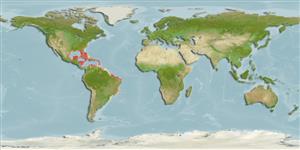Teleostei (teleosts) >
Gobiiformes (Gobies) >
Gobiidae (Gobies) > Gobiinae
Etymology: Coryphopterus: Greek, koryphe = summit + Greek, pteron = fin, wing (Ref. 45335).
More on author: Gill.
Environment: milieu / climate zone / depth range / distribution range
Ecology
Marine; reef-associated; depth range 2 - 45 m (Ref. 9710). Tropical; 37°N - 33°S
Western Atlantic: North Carolina, USA and Bermuda to Santa Catarina, Brazil (Ref. 57756); throughout the Caribbean Sea.
Size / Weight / Age
Maturity: Lm ? range ? - ? cm
Max length : 8.0 cm TL male/unsexed; (Ref. 9710)
Dorsal spines (total): 6; Dorsal soft rays (total): 10; Anal spines: 1; Anal soft rays: 10; Vertebrae: 26. With black spot on side of head above gill cover (Ref. 26938). Individuals from white sand bottom and clear water are pale with two rows of faint yellow spots on side of body; a horizontal orange streak extending posteriorly from middle of eye to above pectoral fin; a row of dusky spots at base of dorsal fins. Individuals from darker bottom and more turbid water are more darkly pigmented; there are 2 rows of dark spots on side of body and one mid-dorsally, fins dusky (Ref. 13442).
Inhabits clear white sandy areas near deep reefs and grassy and rocky areas. Burrows in the sand and the male guards the eggs (Ref. 5521). The Bridled goby, which has X-shaped marks and spots, occurs in both clear and more murky inshore waters, while the paler, very similar Sand goby, Coryphopterus tortugae [= Coryphopterus glaucofraenum], occurs over white sand (Ref. 26938).
Life cycle and mating behavior
Maturity | Reproduction | Spawning | Eggs | Fecundity | Larvae
Oviparous, demersal spawner (Ref. 101194). Both male and female spawn with many individuals in small contiguous territories (Ref. 240).
Robins, C.R. and G.C. Ray, 1986. A field guide to Atlantic coast fishes of North America. Houghton Mifflin Company, Boston, U.S.A. 354 p. (Ref. 7251)
IUCN Red List Status (Ref. 130435: Version 2024-1)
Threat to humans
Harmless
Human uses
Fisheries: commercial; aquarium: commercial
Tools
Can't connect to MySQL database fbquizv2. Errorcode: Too many connections
